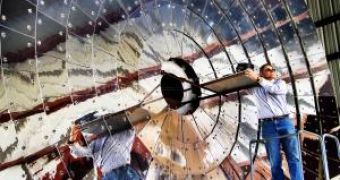The basic principle of this idea is somehow similar to that of the water electrolysis method, meaning partly energizing the atoms of the two chemical elements until they break up to form oxygen and carbon monoxide, which can be used to make hydrogen fuel; or as building blocks in order to synthesize a flammable liquid combustible, like methanol for example, or petroleum derived fuels, such as gasoline and diesel.
The reverse combustion device was originally built by a team of researchers from Sandia National Laboratories, as a prototype intended to extract hydrogen fuel, from water, but was later converted to a so-called Counter Rotating Ring Receiver Reactor Recuperator, or CR 5 for short, with the help of sunlight. What started with the program called 'Sunshine to Petrol', or S2P, resulted in the final prototype called 'Liquid Solar Fuel', which made fuel from water and carbon monoxide, by using the power of the Sun.
According to Ellen B. Stechel, one of the co-researchers of Rich Diver's CR5 program, the recycling of the carbon dioxide through the reverse combustion process is known for a long time; however, it has been highly unpractical, both technically or economically, thus the research in this domain has not been pursued with very much enthusiasm. However, the team that designed the prototype believed that the carbon breakdown was possible, by using a two-stage ingenious degradation process. At the same time, Stechel draws attention to the fact that this might be a way to reduce the greenhouse gases emissions.
Nevertheless, their prototype could take up to twenty years before it will be possible to be released on the market.
The inventor of the prototype, Rich Diver, argues that coal burned in power plants could be used to power the CR5 prototype, by filtering the gases emitted and process the carbon dioxide gas into carbon monoxide, which can be used to make petroleum derived products, such as gasoline, jet fuel, or almost any other type of liquid fuel that could replace the current infrastructure. The synthesized fuel from carbon monoxide could be transported through pipelines, or with the help of trucks to a gas station, just like we are now transporting the gasoline, and would work on most of the Otto and Diesel cycle engines.
The S2P system also includes the plan to create the needed infrastructure for processing the carbon dioxide present in the atmosphere, which could then be processed into fuels that do not emit carbon dioxide during the burning process.
Now, the team hopes that they will be able to prove that the CR 5 concept is practical, by using small scale test experiment after which they could move to the production of the real device. Driver argues that the prototype will be operational by the end of next year, until then though the SNSTTF is still waiting for the finalization of some parts of the prototype.

 14 DAY TRIAL //
14 DAY TRIAL //